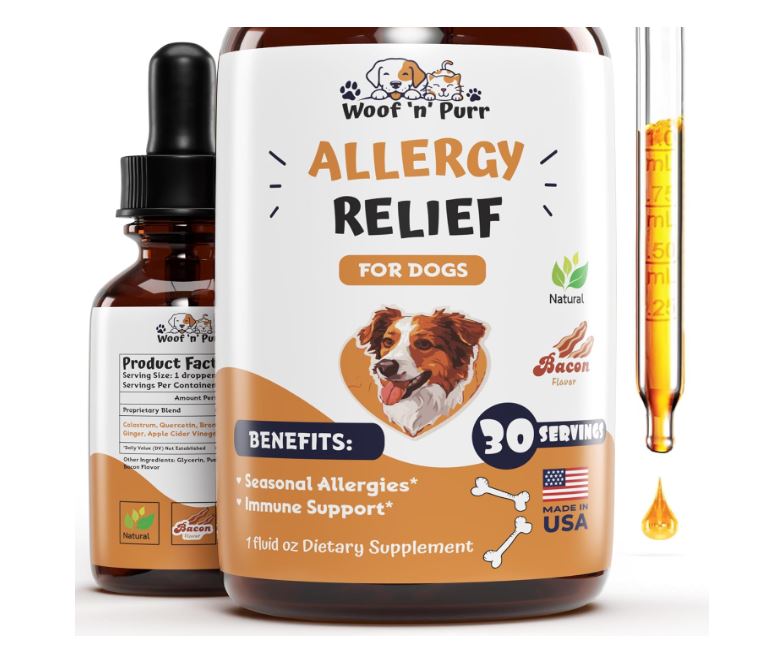The Link Between Seasonal Changes and Dog Itching: What You Need to Know

The Link Between Seasonal Changes and Dog Itching: What You Need to Know
-
Table of Contents
- Introduction
- How to Help Your Dog Find Relief from Seasonal Itching Through Proper Care and Treatment
- Common Allergens That Can Aggravate Your Dog’s Itching in Different Seasons
- Tips for Managing Your Dog’s Itching During Seasonal Transitions
- Understanding the Impact of Seasonal Changes on Dog Itching
- Conclusion
Introduction
Seasonal changes can have a significant impact on our furry friends, particularly when it comes to their skin health. Many dog owners may notice an increase in itching and scratching during certain times of the year, which can be attributed to various environmental factors. Understanding the link between seasonal changes and dog itching is crucial for providing proper care and relief for our beloved pets. In this article, we will explore what you need to know about this connection and how you can help alleviate your dog’s discomfort.
How to Help Your Dog Find Relief from Seasonal Itching Through Proper Care and Treatment
Seasonal changes can have a significant impact on our furry friends, especially when it comes to their skin health. Many dog owners notice an increase in itching and scratching during certain times of the year, and this can be attributed to a variety of factors. Understanding the link between seasonal changes and dog itching is crucial in order to provide your pet with the proper care and treatment they need to find relief.
One of the main reasons why dogs may experience increased itching during certain seasons is due to environmental allergens. Just like humans, dogs can be allergic to pollen, grass, mold, and other outdoor allergens that are more prevalent during certain times of the year. When these allergens come into contact with your dog’s skin, it can trigger an allergic reaction, leading to itching, scratching, and discomfort.
In addition to environmental allergens, changes in temperature and humidity can also play a role in your dog’s skin health. Dry air during the winter months can cause your dog’s skin to become dry and flaky, leading to itching and irritation. On the other hand, high humidity levels during the summer can create the perfect breeding ground for bacteria and yeast, which can also contribute to itching and skin infections.
It’s important to pay attention to your dog’s itching patterns and behavior in order to determine the underlying cause. If you notice that your dog is itching more frequently during certain seasons, it may be a sign that they are allergic to something in their environment. In some cases, seasonal itching may also be a sign of an underlying skin condition, such as atopic dermatitis or flea allergy dermatitis.
Once you have identified the cause of your dog’s seasonal itching, it’s important to take steps to help them find relief. One of the most effective ways to manage seasonal itching is through proper grooming and hygiene practices. Regular baths with a gentle, hypoallergenic shampoo can help remove allergens and soothe your dog’s skin. It’s also important to keep your dog’s coat clean and well-moisturized, especially during dry or humid seasons.
In addition to grooming, you may also want to consider using topical treatments or medications to help alleviate your dog’s itching. Antihistamines, corticosteroids, and other medications can help reduce inflammation and itching caused by allergies. However, it’s important to consult with your veterinarian before using any medications on your dog, as some may have side effects or interactions with other medications.
Another important aspect of managing seasonal itching is to address any underlying skin conditions that may be contributing to your dog’s discomfort. Your veterinarian can help diagnose and treat skin conditions such as atopic dermatitis, flea allergy dermatitis, or bacterial and yeast infections. By addressing these underlying issues, you can help your dog find long-term relief from seasonal itching.
In conclusion, seasonal changes can have a significant impact on your dog’s skin health, leading to increased itching and discomfort. By understanding the link between seasonal changes and dog itching, you can take steps to help your pet find relief through proper care and treatment. From grooming and hygiene practices to topical treatments and medications, there are many ways to manage seasonal itching and improve your dog’s overall skin health. If you notice that your dog is itching more frequently during certain seasons, it’s important to consult with your veterinarian to determine the underlying cause and develop a treatment plan that works best for your furry friend.
Common Allergens That Can Aggravate Your Dog’s Itching in Different Seasons

Seasonal changes can have a significant impact on your dog’s health, particularly when it comes to allergies and itching. Just like humans, dogs can be affected by allergens in the environment that can trigger itching and discomfort. Understanding the common allergens that can aggravate your dog’s itching in different seasons is crucial for managing their symptoms and keeping them comfortable.
In the spring and summer months, pollen is a common allergen that can cause itching in dogs. Pollen from trees, grasses, and weeds can be carried by the wind and land on your dog’s skin, triggering an allergic reaction. Dogs may also inhale pollen, leading to respiratory symptoms such as sneezing and coughing. If your dog is itching more than usual during the spring and summer, pollen may be the culprit.
Another common allergen in the summer months is mould. Mould spores thrive in warm, humid environments, making them prevalent during the summer. Dogs can come into contact with mould spores outdoors or indoors, leading to itching and other allergy symptoms. Keeping your home clean and dry can help reduce your dog’s exposure to mould and alleviate their itching.
As the weather cools down in the fall, ragweed becomes a common allergen that can aggravate your dog’s itching. Ragweed pollen is released into the air in large quantities during the fall months, causing allergic reactions in dogs. If your dog is itching more in the fall, ragweed may be to blame. Keeping your dog indoors during peak ragweed season and wiping their paws after outdoor walks can help reduce their exposure to this allergen.
In the winter months, indoor allergens such as dust mites and pet dander can trigger itching in dogs. Spending more time indoors during the winter can expose your dog to these allergens, leading to itching and discomfort. Regularly vacuuming and dusting your home, washing your dog’s bedding, and grooming your dog regularly can help reduce their exposure to indoor allergens and alleviate their itching.
In addition to environmental allergens, food allergies can also contribute to itching in dogs year-round. Common food allergens for dogs include beef, chicken, dairy, and grains. If your dog is itching consistently regardless of the season, a food allergy may be the cause. Working with your veterinarian to identify and eliminate potential food allergens from your dog’s diet can help alleviate their itching and improve their overall health.
Overall, understanding the common allergens that can aggravate your dog’s itching in different seasons is essential for managing their symptoms and keeping them comfortable. By being aware of potential triggers and taking steps to reduce your dog’s exposure to allergens, you can help alleviate their itching and improve their quality of life. If your dog is experiencing persistent itching or other allergy symptoms, consult with your veterinarian for a proper diagnosis and treatment plan.
Tips for Managing Your Dog’s Itching During Seasonal Transitions
Seasonal changes can have a significant impact on our furry friends, especially when it comes to their skin health. Many dog owners notice an increase in itching and scratching during certain times of the year, such as spring and fall. This can be frustrating for both the dog and their owner, but understanding the link between seasonal changes and dog itching can help you better manage your pet’s discomfort.
One of the main reasons why dogs may experience increased itching during seasonal transitions is due to environmental allergens. Just like humans, dogs can be allergic to pollen, grass, mold, and other outdoor allergens that are more prevalent during certain times of the year. When these allergens come into contact with your dog’s skin, it can trigger an allergic reaction, leading to itching, redness, and irritation.
In addition to environmental allergens, changes in temperature and humidity can also play a role in your dog’s itching. Dry air in the winter months can cause your dog’s skin to become dry and flaky, leading to itching and discomfort. On the other hand, high humidity in the summer can create the perfect breeding ground for bacteria and yeast, which can also contribute to itching and skin infections.
So, what can you do to help manage your dog’s itching during seasonal transitions? The first step is to consult with your veterinarian to determine the underlying cause of your dog’s itching. Your vet may recommend allergy testing to identify specific allergens that are triggering your dog’s symptoms. They may also prescribe medications or recommend dietary changes to help manage your dog’s allergies.
In addition to medical intervention, there are several things you can do at home to help alleviate your dog’s itching. Regular grooming is essential for maintaining your dog’s skin health. Bathing your dog with a gentle, hypoallergenic shampoo can help remove allergens and soothe irritated skin. Be sure to dry your dog thoroughly after baths to prevent moisture from getting trapped in their fur, which can lead to skin infections.
Another important aspect of managing your dog’s itching is to keep their environment clean and free of allergens. Vacuuming and dusting regularly can help reduce the amount of pollen and dust in your home, which can help alleviate your dog’s symptoms. Washing your dog’s bedding and toys frequently can also help prevent the buildup of allergens that can trigger itching.
Finally, it’s essential to pay attention to your dog’s diet during seasonal transitions. Some dogs may have food allergies that can exacerbate their itching symptoms. Your vet may recommend a hypoallergenic diet or specific dietary supplements to help manage your dog’s allergies. Additionally, omega-3 fatty acids can help support your dog’s skin health and reduce inflammation, which can help alleviate itching.
In conclusion, seasonal changes can have a significant impact on your dog’s skin health and lead to increased itching and discomfort. By understanding the link between seasonal changes and dog itching, you can take proactive steps to help manage your dog’s symptoms. Consult with your veterinarian to determine the underlying cause of your dog’s itching and develop a comprehensive treatment plan that includes medical intervention, regular grooming, environmental management, and dietary changes. With proper care and attention, you can help alleviate your dog’s itching and improve their overall quality of life.
Understanding the Impact of Seasonal Changes on Dog Itching
Seasonal changes can have a significant impact on our furry friends, particularly when it comes to their skin health. Many dog owners may notice an increase in itching and scratching during certain times of the year, and this can be attributed to a variety of factors related to the changing seasons.
One of the main reasons why dogs may experience more itching during certain seasons is due to environmental allergens. Just like humans, dogs can be allergic to pollen, mold, dust mites, and other common allergens that are more prevalent during certain times of the year. When these allergens come into contact with a dog’s skin, it can trigger an allergic reaction that leads to itching, redness, and irritation.
In addition to environmental allergens, changes in temperature and humidity can also play a role in exacerbating itching in dogs. For example, dry air during the winter months can cause a dog’s skin to become dry and flaky, leading to increased itching. On the other hand, high humidity during the summer months can create the perfect breeding ground for bacteria and yeast, which can also contribute to skin irritation and itching.
It’s important for dog owners to be aware of these seasonal factors that can impact their pet’s skin health, as untreated itching can lead to more serious skin conditions such as hot spots, infections, and hair loss. If your dog is experiencing persistent itching, it’s important to consult with your veterinarian to determine the underlying cause and develop a treatment plan.
There are several steps that dog owners can take to help alleviate itching in their pets during seasonal changes. Regular grooming and bathing can help remove allergens and bacteria from the skin, while also keeping the coat clean and healthy. Using a gentle, hypoallergenic shampoo can also help soothe irritated skin and reduce itching.
In addition to grooming, it’s important to ensure that your dog is receiving a balanced diet that supports skin health. Omega-3 fatty acids, found in fish oil supplements or certain types of dog food, can help reduce inflammation and improve skin condition. Your veterinarian can provide recommendations on the best diet for your dog’s specific needs.
Another important aspect of managing itching in dogs is to keep their environment clean and free of allergens. Regularly vacuuming and dusting your home can help reduce the amount of allergens that your dog is exposed to, while also creating a healthier living environment for both you and your pet.
Overall, understanding the link between seasonal changes and dog itching is crucial for maintaining your pet’s skin health. By being aware of the factors that can contribute to itching during certain times of the year, you can take proactive steps to help alleviate your dog’s discomfort and keep their skin healthy and happy. Remember to consult with your veterinarian if you have any concerns about your dog’s itching, as they can provide guidance on the best course of action for your furry friend.
Conclusion
Seasonal changes can affect a dog’s skin and coat, leading to increased itching. It is important for pet owners to be aware of these changes and take steps to help alleviate their dog’s discomfort. By understanding the link between seasonal changes and dog itching, owners can better care for their furry friends and ensure they stay healthy and happy.



